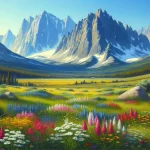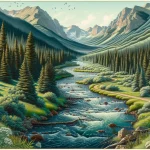Bushnell Peak, standing tall at 13,105 feet, is a prominent Colorado 13er located in the Sangre de Cristo Range. It offers hikers and mountaineers a challenging yet rewarding outdoor adventure.
In This Article
TL;DR
- Bushnell Peak is the highest point in Fremont County and a popular destination for hiking and mountaineering.
- The peak provides stunning summit views of the Rocky Mountains and opportunities for wildlife spotting and nature photography.
- Visitors can enjoy various outdoor activities like camping, backpacking, and exploring nearby towns like Villa Grove.
Destination Overview
Bushnell Peak is a sought-after destination for outdoor enthusiasts in Colorado. As the highest point in Fremont County, it attracts hikers and mountaineers looking to conquer its rugged terrain and bask in the breathtaking alpine environment. The peak’s location in the Sangre de Cristo Range, within the Rio Grande National Forest and San Isabel National Forest, adds to its allure.
Hiking and Mountaineering
Bushnell Peak offers a variety of hiking trails and climbing routes catering to different skill levels. The most popular route, the Northwest Ridge, is a Class 2 scramble that provides a challenging yet accessible climb for experienced hikers. More technical routes, such as the Northeast Ridge (Class 3) and the East Face (Class 4), are available for skilled mountaineers seeking a greater challenge.
Proper preparation is essential for any hike or climb on Bushnell Peak. Hikers should equip themselves with appropriate gear, plenty of water, and a map or GPS device. Additionally, checking weather conditions and being aware of potential hazards like loose rock and steep terrain is crucial for a safe and enjoyable experience.
Nature and Wildlife
The alpine environment surrounding Bushnell Peak is a haven for nature enthusiasts and wildlife spotters. Visitors can expect to encounter a diverse array of flora and fauna, including bighorn sheep, marmots, and various bird species. The peak’s location within the national forests also provides ample opportunities for nature photography, capturing the stunning landscapes and wildlife in their natural habitats.
Responsible outdoor practices are essential to preserve the area’s natural beauty. Visitors should follow Leave No Trace principles, stay on designated trails, and respect wildlife by maintaining a safe distance and avoiding disturbances.
Outdoor Activities Beyond Hiking
While hiking and mountaineering are the primary draws, Bushnell Peak and its surrounding areas offer a variety of other outdoor activities. Camping and backpacking are popular options, with several designated campsites and backcountry areas available. Visitors can also explore nearby trails for mountain biking, rock climbing, and fishing in the area’s streams and lakes.
Summit Views and Photography
One of the most rewarding aspects of conquering Bushnell Peak is the stunning panoramic views from the summit. On a clear day, hikers and climbers can take in breathtaking vistas of the Rocky Mountains, including the nearby Twin Sisters and Cottonwood Peak. These views provide ample opportunities for landscape and nature photography, capturing the beauty of the alpine environment.
Photographers should plan their visits accordingly, considering factors like lighting conditions and weather patterns to capture the best shots. Early morning and late afternoon light can create stunning golden hues, while cloudy days can provide dramatic skies and contrasts.
Local Attractions and Nearby Towns
While Bushnell Peak is the main attraction, visitors can enhance their experience by exploring local attractions and nearby towns. Villa Grove, a small town located near the peak, offers a glimpse into the area’s rich history and culture. Visitors can find local dining options, shops, and cultural sites that provide insight into the region’s heritage.
Other nearby towns, such as Salida and Buena Vista, offer additional recreational opportunities, including whitewater rafting, hot springs, and cultural events. These towns also serve as convenient bases for those planning multi-day adventures in the Sangre de Cristo Range.
Conservation and Environmental Impact
As with any outdoor destination, it is crucial to prioritize conservation efforts and minimize environmental impact in the Bushnell Peak area. Local organizations and land management agencies work tirelessly to preserve the natural beauty and protect the delicate alpine ecosystems.
Visitors can contribute to these efforts by adhering to Leave No Trace principles, properly disposing of waste, and respecting trail closures or restrictions. Additionally, supporting local conservation initiatives and participating in volunteer efforts can help ensure that future generations can continue to enjoy the beauty of Bushnell Peak and its surroundings.
FAQ
What is the best time of year to hike or climb Bushnell Peak?
The ideal time to visit Bushnell Peak is during the summer months, typically from late June to early September, when the weather is more favorable and the trails are mostly clear of snow.
Is any special equipment required for hiking or climbing Bushnell Peak?
For hiking, proper footwear (hiking boots), layers of clothing, sun protection, and plenty of water are essential. For more technical climbs, additional gear like helmets, harnesses, and ropes may be necessary.
Are there any permits or fees required to access Bushnell Peak?
No permits are required for day hikes, but an overnight camping permit may be necessary for backpacking trips. Additionally, a fee is charged for parking at some trailheads.
Are there any services or facilities available near Bushnell Peak?
There are no services or facilities directly at Bushnell Peak, but nearby towns like Villa Grove and Salida offer lodging, dining, and outdoor gear shops.
What should I do if I encounter wildlife while hiking or climbing Bushnell Peak?
Maintain a safe distance from wildlife and avoid approaching or disturbing them. Make noise to alert animals of your presence and give them a wide berth. Never feed or attempt to interact with wild animals.







